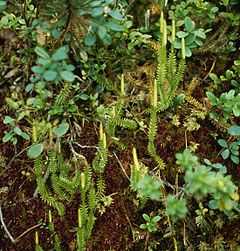Lycopodiaceae
| Lycopodiaceae (Clubmosses) | |
|---|---|
 | |
| Lycopodium annotinum | |
| Scientific classification | |
| Kingdom: | Plantae |
| Division: | Lycopodiophyta |
| Class: | Lycopodiopsida |
| Order: | Lycopodiales |
| Family: | Lycopodiaceae |
| Genera | |
|
Austrolycopodium | |

| Wikimedia Commons has media related to Lycopodiaceae. |
The Lycopodiaceae (class Lycopodiopsida, order Lycopodiales) are a family of vascular plants, including all of the core clubmosses. These plants bear spores on specialized structures at the apex of a shoot; they resemble a tiny battle club, from which the common name derives. They are non-flowering and do not produce seeds.
The genera Huperzia, Phlegmariurus and Phylloglossum, the species of which were generally included in a more broadly defined Lycopodium in older classifications, are treated in the separate family Huperziaceae in some classifications, and are treated so here; they differ in producing spores in small lateral structures in the leaf axils. There is as yet no consensus on the recognition of Huperziaceae as a separate family; a more broadly defined Lycopodiaceae, including these genera, is still recognized in some classifications.
The species within this family generally have chromosome counts of n=34. A notable exception are the species in genus Diphasiastrum, which have counts of n=23.
Uses
- The running clubmosses (genus Diphasiastrum) have long been used as greenery for Christmas decoration.
- The spores have long been used as a flash powder. See Lycopodium powder.
- The spores have been used by violin makers for centuries as a pore filler.
- In Cornwall, club mosses gathered during certain lunar phases were historically used as a remedy for eye disease.
References and external links
- Thiselton-Dyer, Thomas F. (1889). The Folk-lore of Plants.
- Wagner, W. H. Jr. & J. M. Beitel. 1992. Generic classification of modern North American Lycopodiaceae. Ann. Missouri Bot. Gard. 79: 676-686.
- Lycopodiaceae in Flora of North America (follows a broad circumscription of the family, including Huperziaceae)